The biocement market is projected to grow from USD 910.4 million in 2025 to USD 1,615.1 million by 2035, reflecting a CAGR of 5.9%. The growth rate volatility index measures the consistency and stability of expansion across this period. It highlights phases where the biocement market may experience accelerated momentum, temporary slowdowns, or gradual stabilization. For biocement, volatility is shaped by production costs, regulatory frameworks, and the pace of adoption across construction and infrastructure projects. The overall trend remains upward, yet within this trajectory, short-term oscillations are expected.
From 2025 to 2030, the volatility index is likely to record moderate levels. Biocement adoption will grow, but large-scale deployment requires time to stabilize. Production optimization, microbial strain selection, and cost-effective scaling are still in development. Early-stage fluctuations stem from uneven acceptance across industries such as commercial construction, public infrastructure, and residential projects. Regulatory adaptations also play a role, as safety and durability standards vary by region and require compliance testing. Raw material pricing, feedstock availability, and technology licensing costs add layers of variability. Despite these uncertainties, rising awareness of eco-efficient building materials drives demand upward. Support from sustainability-focused construction projects and government-backed initiatives ensures that volatility remains within a manageable range, rather than creating disruptive downturns.
Between 2030 and 2035, the growth rate volatility index is expected to decline. Biocement manufacturing technologies achieve greater maturity. Economies of scale bring down unit costs, while process efficiencies reduce dependence on expensive inputs. Continuous research in microbial-induced calcite precipitation (MICP) leads to more reliable formulations and broader commercial acceptance. Integration into sustainable construction practices improves predictability of demand, and market penetration extends across infrastructure restoration, soil stabilization, and green building projects. Regulatory frameworks become more standardized, with certifications and safety codes providing clarity for adoption. These factors contribute to smoother growth patterns and lower fluctuations.
The overall volatility profile of the biocement market suggests stability rather than abrupt shifts. Early fluctuations give way to steady, predictable expansion. The adoption curve reflects a transition from initial trials and pilot projects toward mainstream integration in large-scale infrastructure. The index captures this journey by showing higher variability in the early period and a gradual reduction as technologies, regulations, and supply chains mature. Long-term drivers such as urban development, climate-resilient infrastructure, and demand for sustainable construction ensure consistent upward growth.
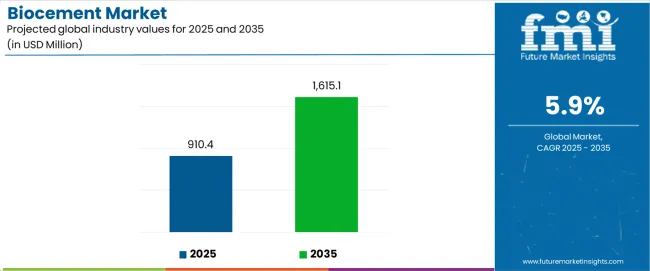
| Period | Primary Revenue Buckets | Share | Notes |
|---|---|---|---|
| Today | Natural minerals-based biocement | 52% | Traditional materials, established construction |
| Industrial waste-based biocement | 43% | Cost-effective properties, infrastructure projects | |
| Specialized biological additives | 5% | Advanced applications, premium constructions | |
| Future (3-5 yrs) | Advanced natural mineral systems | 48-50% | Enhanced strength, rapid setting |
| High-performance waste-derived solutions | 35-38% | Circular economy, cost optimization | |
| Construction applications | 18-22% | Infrastructure projects, building construction | |
| Environmental remediation | 15-18% | Soil stabilization, crack healing | |
| Precast concrete manufacturing | 8-12% | Industrial production, quality control | |
| Custom & specialty applications | 4-8% | Research projects, innovative constructions |
| Metric | Value |
|---|---|
| Market Value (2025) | USD 910.4 million |
| Market Forecast (2035) | USD 1,615.1 million |
| Growth Rate | 5.9% CAGR |
| Leading Raw Material | Natural Minerals-Based Solutions |
| Primary Application | Construction Segment |
The biocement market demonstrates strong fundamentals with natural minerals-based biocement systems capturing a dominant share through advanced biological properties and commercial application optimization. Construction applications drive primary demand, supported by increasing infrastructure requirements and building industry modernization initiatives. Geographic expansion remains concentrated in developed markets with established construction infrastructure, while emerging economies show accelerating adoption rates driven by infrastructure development initiatives and rising environmental standards.
Primary Classification: The biocement market segments by raw material type into natural minerals, industrial waste, and others, representing the evolution from traditional mineral sources to sophisticated waste utilization approaches for comprehensive biocement optimization.
Secondary Classification: Application segmentation divides the biocement market into construction, environmental remediation, and others, reflecting distinct requirements for biocement performance, durability standards, and application specifications.
Tertiary Classification: End-use segmentation covers infrastructure companies, construction contractors, environmental firms, precast manufacturers, and research institutions, while distribution channels span direct sales, construction distributors, and specialized building material suppliers.
Regional Classification: Geographic distribution covers North America, Latin America, Western Europe, Eastern Europe, East Asia, South Asia Pacific, and Middle East & Africa, with developed markets leading adoption while emerging economies show accelerating growth patterns driven by infrastructure development programs.
The segmentation structure reveals material progression from traditional natural mineral-based biocement toward sophisticated waste-derived solutions with enhanced environmental capabilities, while application diversity spans from large infrastructure projects to specialized environmental remediation requiring precision biocement solutions.
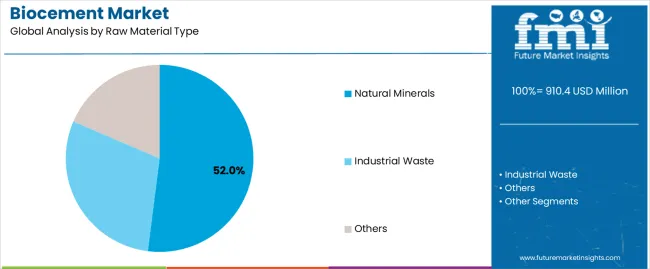
Market Position: Natural minerals-based biocement systems command the leading position in the biocement market with 52% market share through proven biological technologies, including enhanced strength properties, reliable performance characteristics, and construction compatibility optimization that enable infrastructure operators to achieve optimal structural performance across diverse construction and building environments.
Value Drivers: The segment benefits from construction industry preference for proven biocement systems that provide reliable strength development, predictable performance, and structural durability without requiring complex waste processing infrastructure. Advanced mineral processing features enable enhanced biological activity, controlled setting properties, and integration with existing construction programs, where strength performance and structural reliability represent critical operational requirements.
Competitive Advantages: Natural minerals-based biocement systems differentiate through proven strength reliability, consistent biological characteristics, and integration with established construction management systems that enhance project effectiveness while maintaining optimal structural standards suitable for diverse construction applications.
Key market characteristics:
Industrial waste-based biocement systems maintain a 43% market position in the biocement market due to their cost advantages and environmental positioning benefits. These materials appeal to facilities requiring efficient biocement solutions with enhanced resource utilization profiles for large-scale operations. Market growth is driven by infrastructure expansion, emphasizing circular economy solutions and operational efficiency through optimized waste utilization designs.
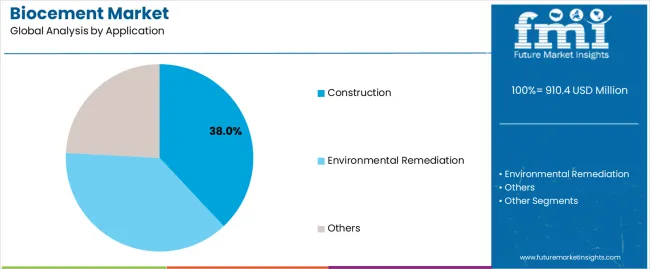
Market Context: Construction applications demonstrate strong growth in the biocement market with 6.5% CAGR and 38 % market share due to widespread adoption of biological cement systems and increasing focus on infrastructure excellence, operational cost efficiency, and structural performance applications that maximize biocement effectiveness while maintaining construction standards.
Appeal Factors: Construction operators prioritize biocement reliability, structural consistency, and integration with existing building infrastructure that enables coordinated construction operations across multiple project phases. The segment benefits from substantial infrastructure investment and modernization programs that emphasize the acquisition of advanced biocement for structural optimization and performance applications.
Growth Drivers: Infrastructure expansion programs incorporate biocement as essential components for construction operations, while green building growth increases demand for biocement capabilities that comply with environmental standards and minimize construction complexity.
Market Challenges: Varying construction requirements and project scale complexity may limit biocement standardization across different projects or building scenarios.
Application dynamics include:
Environmental remediation applications capture 35% market share through specialized performance requirements in soil stabilization, crack healing, and environmental applications. These facilities demand premium biocement capable of supporting environmental requirements while providing structural enhancement, access, and performance optimization capabilities.
Market Context: Infrastructure Companies dominate the biocement market with a 6.8% CAGR, reflecting the primary demand source for biocement technology in construction applications and project standardization.
Business Model Advantages: Infrastructure Companies provide direct market demand for standardized biocement systems, driving volume production and cost optimization while maintaining quality control and performance consistency requirements.
Operational Benefits: Infrastructure Company applications include project standardization, cost efficiency, and quality assurance that drive consistent demand for biocement systems while providing access to latest biological technologies.
| Category | Factor | Impact | Why It Matters |
|---|---|---|---|
| Driver | Infrastructure development & construction expansion (urbanization trends, building modernization) | ★★★★★ | Growing construction market requires biological cement with enhanced structural capabilities and performance properties proven effective across building applications. |
| Driver | Environmental regulations advancement & green building requirements (carbon reduction, resource efficiency) | ★★★★★ | Transforms biocement requirements from "alternative material" to "environmental solution"; operators that offer biological cement and compliance features gain competitive advantage. |
| Driver | Advanced construction market growth & structural excellence (high-performance buildings, innovative designs) | ★★★★☆ | Advanced construction projects need distinctive, high-quality biocement; demand for superior and specialized biocement solutions expanding addressable market. |
| Restraint | Cost pressures & budget constraints (especially for small construction projects) | ★★★★☆ | Smaller construction operators defer biocement adoption; increases price sensitivity and slows premium biocement adoption in cost-conscious markets. |
| Restraint | Alternative cement options competition (traditional Portland cement, other green alternatives) | ★★★☆☆ | Traditional cement alternatives offer established supply chains and proven performance, potentially limiting biocement adoption in conventional applications. |
| Trend | Biological technology integration & performance enhancement (microbial optimization, strength development) | ★★★★★ | Advanced biological properties, strength optimization, and performance analytics transform operations; technology integration and performance enhancement become core value propositions. |
| Trend | Customization & application-specific solutions (project requirements, performance matching) | ★★★★☆ | Custom biocement for specific applications and projects; specialized formulations and targeted performance capabilities drive competition toward customization solutions. |
The biocement market demonstrates varied regional dynamics with Growth Leaders including China (8.0% growth rate) and India (7.4% growth rate) driving expansion through 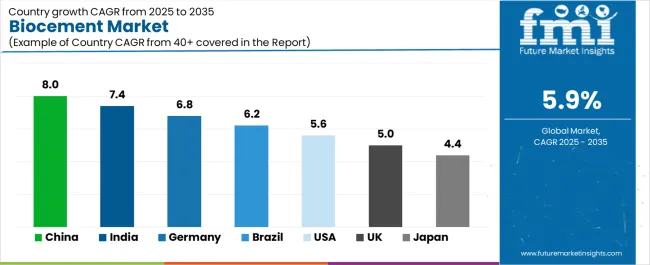 infrastructure development initiatives and construction industry modernization. Steady Performers encompass Germany (6.8% growth rate), Brazil (6.2% growth rate), and developed regions, benefiting from established construction industries and environmental regulation adoption. Mature Markets feature United States (5.6% growth rate), United Kingdom (5.0% growth rate), and Japan (4.4% growth rate), where infrastructure advancement and environmental standardization requirements support consistent growth patterns.
infrastructure development initiatives and construction industry modernization. Steady Performers encompass Germany (6.8% growth rate), Brazil (6.2% growth rate), and developed regions, benefiting from established construction industries and environmental regulation adoption. Mature Markets feature United States (5.6% growth rate), United Kingdom (5.0% growth rate), and Japan (4.4% growth rate), where infrastructure advancement and environmental standardization requirements support consistent growth patterns.
Regional synthesis reveals East Asian markets leading adoption through infrastructure expansion and construction development, while North American countries maintain steady expansion supported by biocement technology advancement and environmental standardization requirements. European markets show strong growth driven by construction applications and environmental integration trends.
| Region/Country | 2025-2035 Growth | How to win | What to watch out |
|---|---|---|---|
| China | 8.0% | Focus on large-scale infrastructure solutions | Regulatory changes; local competition |
| India | 7.4% | Lead with cost-effective manufacturing | Import restrictions; quality barriers |
| Germany | 6.8% | Provide premium environmental solutions | Over-regulation; lengthy approvals |
| Brazil | 6.2% | Offer infrastructure-oriented solutions | Currency fluctuations; import duties |
| United States | 5.6% | Push technology integration | Compliance costs; scaling challenges |
| United Kingdom | 5.0% | Focus on environmental applications | Economic impacts; material costs |
| Japan | 4.4% | Emphasize quality manufacturing | Traditional preferences; adoption rates |
China establishes fastest market growth through aggressive infrastructure development programs and comprehensive construction industry expansion, integrating advanced biocement systems as standard components in building facilities and infrastructure installations. The country's 8.0% growth rate reflects government initiatives promoting infrastructure modernization and domestic biocement capabilities that mandate the use of biological cement systems in construction and building facilities. Growth concentrates in major infrastructure hubs, including Beijing, Shanghai, and Guangzhou, where construction development showcases integrated biocement systems that appeal to construction operators seeking structural performance optimization capabilities and building applications.
Chinese manufacturers are developing cost-effective biocement solutions that combine domestic production advantages with advanced biological features, including enhanced strength control and improved performance capabilities. Distribution channels through construction suppliers and building material distributors expand market access, while government support for infrastructure development supports adoption across diverse construction and building segments.
Strategic Market Indicators:
In Mumbai, Delhi, and Bangalore, construction facilities and infrastructure operators are implementing biological biocement systems as standard materials for structural performance and building optimization applications, driven by increasing government infrastructure investment and construction modernization programs that emphasize the importance of environmental performance capabilities. The biocement market holds a 7.4% growth rate, supported by government infrastructure initiatives and building development programs that promote biological biocement systems for construction and infrastructure facilities. Indian operators are adopting biocement systems that provide consistent structural performance and environmental features, particularly appealing in urban regions where building performance and construction excellence represent critical business requirements.
Market expansion benefits from growing construction capabilities and international infrastructure partnerships that enable domestic production of biological biocement systems for construction and infrastructure applications. Technology adoption follows patterns established in construction materials, where reliability and performance drive procurement decisions and operational deployment.
Market Intelligence Brief:
Germany's advanced construction market demonstrates sophisticated biocement deployment with documented structural effectiveness in building applications and infrastructure facilities through integration with existing construction systems and operational infrastructure. The country leverages engineering expertise in biotechnology and construction systems integration to maintain a 6.8% growth rate. Construction centers, including Bavaria, Baden-Württemberg, and North Rhine-Westphalia, showcase premium installations where biocement systems integrate with comprehensive building platforms and facility management systems to optimize structural performance and operational effectiveness.
German manufacturers prioritize system quality and EU compliance in biocement development, creating demand for premium systems with advanced features, including facility integration and structural performance systems. The biocement market benefits from established construction infrastructure and a willingness to invest in biological biocement technologies that provide long-term operational benefits and compliance with international building standards.
Market Intelligence Brief:
Brazil's market expansion benefits from diverse infrastructure demand, including construction modernization in Rio de Janeiro and São Paulo, building facility upgrades, and government infrastructure programs that increasingly incorporate biological biocement solutions for construction applications. The country maintains a 6.2% growth rate, driven by rising infrastructure activity and increasing recognition of biocement benefits, including precise structural control and enhanced operational effectiveness.
Market dynamics focus on cost-effective biocement solutions that balance structural performance with affordability considerations important to Brazilian construction operators. Growing infrastructure industrialization creates continued demand for modern biocement systems in new construction infrastructure and facility modernization projects.
Strategic Market Considerations:
United States establishes market leadership through comprehensive infrastructure programs and advanced construction infrastructure development, integrating biocement systems across building and infrastructure applications. The country's 5.6% growth rate reflects established construction industry relationships and mature biocement technology adoption that supports widespread use of biological biocement systems in construction and building facilities. Growth concentrates in major construction centers, including California, New York, and Texas, where biocement technology showcases mature deployment that appeals to construction operators seeking proven structural capabilities and operational efficiency applications.
American construction providers leverage established distribution networks and comprehensive technical support capabilities, including application programs and training support that create customer relationships and operational advantages. The biocement market benefits from mature regulatory standards and construction requirements that mandate biocement system use while supporting technology advancement and operational optimization.
Market Intelligence Brief:
United Kingdom's construction market demonstrates integrated biocement deployment with documented structural effectiveness in building applications and infrastructure facilities through integration with existing construction systems and operational infrastructure. The country maintains a 5.0% growth rate, supported by environmental excellence programs and structural effectiveness requirements that promote biological biocement systems for construction applications. Building facilities across England, Scotland, and Wales showcase systematic installations where biocement systems integrate with comprehensive construction platforms to optimize structural performance and operational outcomes.
UK construction providers prioritize system reliability and industry compatibility in biocement procurement, creating demand for validated systems with proven structural features, including quality monitoring integration and performance enhancement systems. The biocement market benefits from established construction infrastructure and environmental requirements that support biocement technology adoption and operational effectiveness.
Market Intelligence Brief:
Japan's market growth benefits from precision construction demand, including advanced building facilities in Tokyo and Osaka, quality integration, and structural enhancement programs that increasingly incorporate biocement solutions for performance applications. The country maintains a 4.4% growth rate, driven by construction technology advancement and increasing recognition of precision biocement benefits, including accurate structural control and enhanced building outcomes.
Market dynamics focus on high-precision biocement solutions that meet Japanese quality standards and structural effectiveness requirements important to construction operators. Advanced construction technology adoption creates continued demand for sophisticated biocement systems in building facility infrastructure and construction modernization projects.
Strategic Market Considerations:
The European biocement market is projected to grow from USD 201.5 million in 2025 to USD 343.2 million by 2035, registering a CAGR of 5.5% over the forecast period. Germany is expected to maintain its leadership position with a 36.8% market share in 2025, supported by its advanced construction infrastructure and major infrastructure centers.
United Kingdom follows with a 26.2% share in 2025, driven by comprehensive environmental programs and construction excellence development initiatives. France holds a 19.1% share through specialized construction applications and environmental compliance requirements. Italy commands a 11.4% share, while Spain accounts for 6.5% in 2025. The rest of Europe region is anticipated to gain momentum, expanding its collective share from 4.1% to 4.6% by 2035, attributed to increasing construction adoption in Nordic countries and emerging infrastructure facilities implementing construction modernization programs.
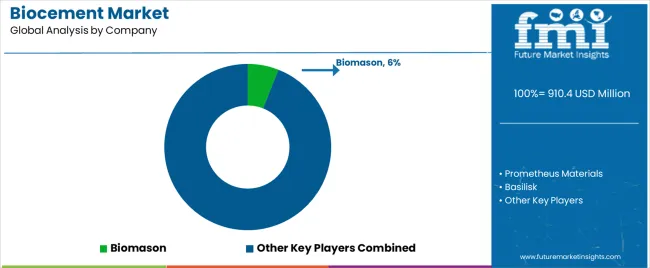
| Stakeholder | What they actually control | Typical strengths | Typical blind spots |
|---|---|---|---|
| Global brands | Distribution reach, broad product catalogs, brand recognition | Wide availability, proven quality, multi-region support | Product refresh cycles; customer dependency on brand validation |
| Technology innovators | Biological R&D; advanced microbial technologies; enhanced performance properties | Latest technologies first; attractive ROI on performance effectiveness | Service density outside core regions; scaling complexity |
| Regional specialists | Local compliance, fast delivery, nearby customer support | "Close to customer" support; pragmatic pricing; local regulations | Technology gaps; talent retention in customer service |
| Full-service providers | Biocement programs, application services, technical support | Lowest operational risk; comprehensive support | Service costs if overpromised; technology obsolescence |
| Niche specialists | Specialized applications, custom formulations, research services | Win premium applications; flexible configurations | Scalability limitations; narrow market focus |
| Item | Value |
|---|---|
| Quantitative Units | USD 910.4 million |
| Raw Material Type | Natural Minerals, Industrial Waste, Others |
| Application | Construction, Environmental Remediation, Others |
| End Use | Infrastructure Companies, Construction Contractors, Environmental Firms, Precast Manufacturers, Research Institutions |
| Regions Covered | North America, Latin America, Western Europe, Eastern Europe, East Asia, South Asia Pacific, Middle East & Africa |
| Countries Covered | China, India, Germany, Brazil, United States, United Kingdom, Japan, Canada, France, Australia, and 25+ additional countries |
| Key Companies Profiled | Biomason, Prometheus Materials, Basilisk, Biohm, Bio-Protective Technologies, Seratech, Solidia Technologies, CarbonCure Technologies, Blue Planet |
| Additional Attributes | Dollar sales by raw material type and application categories, regional adoption trends across East Asia, North America, and Western Europe, competitive landscape with biotechnology manufacturers and construction suppliers, construction operator preferences for biocement effectiveness and structural performance, integration with construction platforms and quality management systems, innovations in biological technology and biocement enhancement, and development of advanced biocement solutions with enhanced performance and operational optimization capabilities. |
The global biocement market is estimated to be valued at USD 910.4 million in 2025.
The market size for the biocement market is projected to reach USD 1,615.1 million by 2035.
The biocement market is expected to grow at a 5.9% CAGR between 2025 and 2035.
The key product types in biocement market are natural minerals , industrial waste and others.
In terms of application, construction segment to command 38.0% share in the biocement market in 2025.






Our Research Products

The "Full Research Suite" delivers actionable market intel, deep dives on markets or technologies, so clients act faster, cut risk, and unlock growth.

The Leaderboard benchmarks and ranks top vendors, classifying them as Established Leaders, Leading Challengers, or Disruptors & Challengers.

Locates where complements amplify value and substitutes erode it, forecasting net impact by horizon

We deliver granular, decision-grade intel: market sizing, 5-year forecasts, pricing, adoption, usage, revenue, and operational KPIs—plus competitor tracking, regulation, and value chains—across 60 countries broadly.

Spot the shifts before they hit your P&L. We track inflection points, adoption curves, pricing moves, and ecosystem plays to show where demand is heading, why it is changing, and what to do next across high-growth markets and disruptive tech

Real-time reads of user behavior. We track shifting priorities, perceptions of today’s and next-gen services, and provider experience, then pace how fast tech moves from trial to adoption, blending buyer, consumer, and channel inputs with social signals (#WhySwitch, #UX).

Partner with our analyst team to build a custom report designed around your business priorities. From analysing market trends to assessing competitors or crafting bespoke datasets, we tailor insights to your needs.
Supplier Intelligence
Discovery & Profiling
Capacity & Footprint
Performance & Risk
Compliance & Governance
Commercial Readiness
Who Supplies Whom
Scorecards & Shortlists
Playbooks & Docs
Category Intelligence
Definition & Scope
Demand & Use Cases
Cost Drivers
Market Structure
Supply Chain Map
Trade & Policy
Operating Norms
Deliverables
Buyer Intelligence
Account Basics
Spend & Scope
Procurement Model
Vendor Requirements
Terms & Policies
Entry Strategy
Pain Points & Triggers
Outputs
Pricing Analysis
Benchmarks
Trends
Should-Cost
Indexation
Landed Cost
Commercial Terms
Deliverables
Brand Analysis
Positioning & Value Prop
Share & Presence
Customer Evidence
Go-to-Market
Digital & Reputation
Compliance & Trust
KPIs & Gaps
Outputs
Full Research Suite comprises of:
Market outlook & trends analysis
Interviews & case studies
Strategic recommendations
Vendor profiles & capabilities analysis
5-year forecasts
8 regions and 60+ country-level data splits
Market segment data splits
12 months of continuous data updates
DELIVERED AS:
PDF EXCEL ONLINE
Calcium Carbonate Biocement Market Size and Share Forecast Outlook 2025 to 2035

Thank you!
You will receive an email from our Business Development Manager. Please be sure to check your SPAM/JUNK folder too.
Chat With
MaRIA